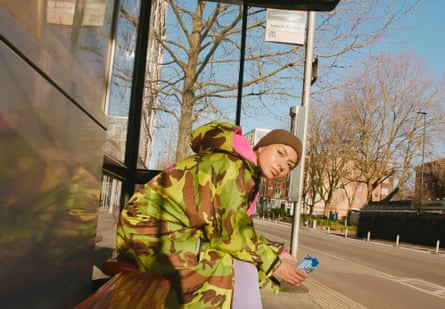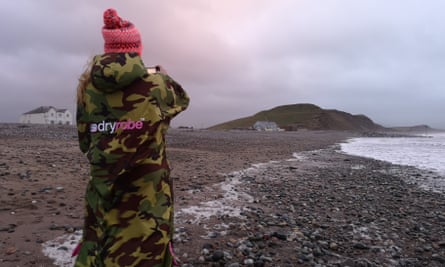During the spring lockdown in 2020, Christopher Sloman was walking down a street in Hove when he saw what looked like a green dinosaur looming towards him. The 48-year-old charity shop worker was baffled by the figure in the distance – until he realised it was a woman whose coat was so oversized that her hands (one carrying a phone, the other a coffee) “looked really small,” Sloman says. “I thought: My God, what on earth is that?”
“That” turned out to be a Dryrobe – the £160 ankle-length, waterproof robe designed as an outdoor changing robe for surfers in 2010 which has become the go-to piece of kit for any half-serious outdoor swimmer.
If cold swimming became the pandemic’s Olympic sport – and an increase of 50% and more of cold-water swimmers as reported by the Outdoor Swimming Society (OSS) suggests it has – then Dryrobes were its uniform. With its towelled interior designed to help the sea-soaked get dry, the robe is oversized so you can get changed underneath it, pulling your arms inside to take off your swimwear without flashing – and many find it coat-like enough to wear home.

Slowly but surely though, as we spent more time not simply in cold ponds but outdoors in general, Dryrobes began migrating inland. On his Instagram page @dry_robe_count, Sloman has spent the last year documenting Dryrobes where Dryrobes were not designed to be. There’s the woman in the supermarket; the mum on the school run; the man in the cafe; Russell Brand in a field of sheep. Elise Wilkins, a 28-year-old Brighton resident who runs the similar page, @DoYouOwnACoat, believes Dryrobes are favoured by the middle-aged and the middle class. “It’s a status symbol,” she says. Though she swims herself, Wilkins laughs when asked if she’d ever get one. “Oh my God! I can’t afford it!”
Beyond Brighton, the fashion world has also taken notice of the robe. Grazia magazine has branded Dryrobes “the must-have, all-season coat” – while Amy de Klerk, digital fashion editor of Harper’s Bazaar, says Dryrobes remind her of the “comically oversized Balenciaga coats” that hit the runway in 2018.
One particular Dryrobe may have played a part. You can get them in blue, black, red and purple, but the most eyecatching is a camo number with a hot-pink fluffy interior. While company founder Gideon Bright says sales are even across each colour (and customers in general are “an equal split of men and women”), the camo-pink combo is the Dryrobe that most often gets papped on Instagram pages such as Sloman’s. They don’t just stand out – Sloman thinks that people wearing them want to stand out.
How and why did a speciality surfing robe become a fashion statement, and how did it come to inspire, if not an all-out culture war, at least a culture tiff? In November 2020, a laminated sign appeared on a lamppost in Sandycove, Ireland: “By order” read big bold letters: “No Dryrobe or Dryrobe types!!!”. When another sign sprang up in nearby Blackrock, warning to “beware of Dryrobe wankers”, a counter-revolution began, with “types” creating the “I am Spartacus”-esque solidarity hashtag #dryrobewankers.

It has taken 12 years for Dryrobe to reach this point. It started, the tidy marketing story goes, when Bright’s mum sewed him a cape. Bright is a 54-year-old dad from north Devon who has surfed from a young age – when he was 16, his mum made him a waterproof robe with a towel lining and a hood so he could stay warm and change more easily on the beach. Years later, he improved on the prototype in his shed, selling the first official Dryrobe in December 2010. In 2012, production moved to China, and in 2016 the brand partnered with Adidas to produce Team GB Dryrobes for Olympic swimmers and divers. By last summer, Dryrobes had appeared in Vogue, newspaper style pages and on Rita Ora.
Today, runners, mountain bikers and campers swear by Dryrobes, though Bright says the company didn’t actively market to other hobbyists: “It just spread naturally into other activities as people discovered how useful it can be.” Bright didn’t suddenly decide to invest millions of pounds to ensure Dryrobe took over the streets. No, it turns out that That Thing That Changed Everything in 2020 even changed the popularity of towelled robes.
Anna Deacon, author of Taking the Plunge and The Art of Wild Swimming, says the popularity of wild swimming went “crackers” thanks to Covid-19 lockdowns. Her local wild swimming Facebook group went from 40-50 swimmers to 2,500.
There are now a number of similar robes available, part of a growing category of post-swimwear. You can buy post-swimming robes from Shore, Robie and Mountain Warehouse. In 2020, two wild swimmers created Wylding, a £160 fleece-lined boiler suit available in three colours – marine blue, moss green and midnight black – that’s designed for the fashion-conscious as well as the wet.
Deacon’s family own multiple Dryrobes – she bought her first five years ago when she started swimming outdoors regularly after moving from London to Edinburgh. “Dryrobes are incredibly useful,” she says, “It’s quite difficult to get changed on a beach when you’re very cold without dropping your towel and flashing your boobs or your bum. They don’t look great, but they’re practical.”
Except, well, plenty of people seem to think they do look great – or at least good enough to wear in the supermarket or the pub. Like the Ugg and the Croc before it, the Dryrobe is a divisive piece of clothing, inspiring ire but continuing to grow in popularity. Bright himself admits that when he was first testing prototypes, people gave him “funny stares” at the beach – so how exactly did the Dryrobe leapfrog into fashion? How did a changing robe become a coat?
Cost is a factor. Sloman, who has lived in Brighton since 1988, says: “The people who tend to wear them are the ones who came down [to Brighton] from London and exchanged flats for big houses here.” For him, the coats have become a symbol of gentrification. He estimates you can spot “10 in half an hour” on Hove seafront, but the best place he saw a Dryrobe was outside Waitrose. The woman wearing it “was doing squats in her Dryrobe in the queue,” he marvels.
Whether or not there is a particular “Dryrobe type” doesn’t change the fact that plenty of people think there is; there’s a “dryrobe wankers” Facebook group with 478 members that bemoans “people using a Dryrobe for anything else other than its intended purpose”. Though Deacon only dons her robe after swimming – and then, only in winter – she defends those seen wearing them elsewhere. “You might drive to go swimming and then on the way back, you go to the supermarket. It might not be an intentional thing of, ‘Look at my lifestyle,’” she says.
Has this culture war affected sales? Bright won’t say, only offering: “It was actually all pretty good-natured fun when we looked into it.” But Google Trends, a tool that monitors the relative popularity of a search term over the years, shows that “dryrobe” searches began growing steadily in the summer of 2020. And (unpaid, accidental) celebrity endorsements helped – when Harry Styles was pictured wearing a Dryrobe after swimming in the sea for a film scene in May 2021, Google searches saw a healthy boost (he was pictured in one again last month). Perhaps it helps that, from a distance, Dryrobes don’t look too dissimilar from the long, padded jackets sold at Uniqlo or Moncler.
Those who love their Dryrobes really do love them – a Facebook fanpage, “Dryrobe Owners’ Club”, has 3,000 members. “I’m not bothered what others think,” says member Gail Moorhouse, a 50-year-old civil servant from Huddersfield. Moorhouse bought her black, turquoise-lined Dryrobe for dog walking and camping: she doesn’t actually swim outdoors. “I loved it from the first time I used it,” she says, praising its big pockets, overall size and warmth. She has worn it to the pub in bad weather.
Bright doesn’t point to any one particular marketing drive or branding decision that made the Dryrobe what it is today – though the company has hired athletes (such as surfers Ben and Lukas Skinner) as ambassadors, and the company supports outdoor activity charities through its Dryrobe Warmth Project. Perhaps the real trick was creating something equally as loved as it is hated. “Do you know something? I’ve got nothing against people using them for what they’re for,” Sloman says. “The problem is that Dryrobe has become more than what it’s used for.” Could the boom be just a temporary fad? “I think it’s getting worse,” he says. “They’ve even got Dryrobe doggie coats now.”
Hair and makeup: Delilah Blakeney using Charlotte Tilbury. Model: Marion at Body London. Styling assistant: Peter Bevan. DryRobe, £160, dryrobe.com. Shop photo: grey sweatshirt, ksubi.uk; trousers, holzweileroslo.com; Socks, monki.com; Shoes, by Tretorn from arket.com. this page: Brown sweatshirt, samsoe.com; Lilac trousers, americanvintage.com; Shoes, craghoppers.com; Hat, redwingheritage.com
